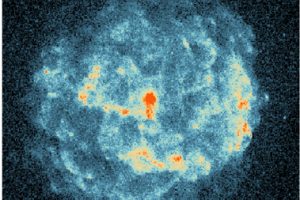The mechanism responsible for the formation of magnetars? The study: “Spatially resolved X-ray study of supernova remnants that host magnetars: Implication of their fossil field origin” of P. Zhou (University of Amsterdam/Nanjing University) recently appeared on A&A

At the end of their evolution, stars with a final mass larger than 8 solar masses (“final mass” because massive stars lose a large fraction of their mass as stellar winds during their evolution) explode as Core-Collapse Supernovae, e.g. triggered by the collapse of their nucleus. Two objects are produced by such explosions: the supernova remnant formed by the ejected stellar atmosphere, and a compact object, a neutron star or a black hole, formed by the collapse of the nucleus.
Neutron stars are complex objects with very high density (a mass larger than that of the Sun enclosed in a sphere with a 10 km radius). They are constituted mainly by a superfluid of neutrons surrounded by a solid crust, and they are characterized by an intense magnetic field and rapid rotation. Magnetars are a particular class of neutron stars. Their magnetic fields are particularly intense (1014-1015 Gauss; as comparison, the magnetic field of the Solar magnetic active regions, such as sunspots, has an intensity of 2000-3000 Gauss), and their rotation is slower (with a period between 2-12 sec) compared with that of other classes of neutron stars. Nowadays, two mechanisms have been proposed to explain the formation of magnetars: dynamo process involving the fluid motion in a rapidly spinning neutron star or the presence of an intense magnetic field in the nucleus of the progenitor, amplified by its collapse.
The team led by the astronomer P. Zhou (University of Amsterdam/Nanjing University), have tried to discriminate between these two hypothesis by analyzing three supernova remnants hosting magnetars, in order to determine the properties of the exploded star (the progenitor) and the processes acting during the supernovae. The team has analyzed X-ray observations obtained with the NASA satellite Chandra of the remnants Kes 73, RCW 103, and N49, estimating the mass of their progenitors (11–15 solar masses for Kes 73, < 13 solar masses for RCW 103, and 13−17 solar masses for N49), and the energy released by the supernovae explosions, ranging between 1050 and 1.7×1051 erg (more than the total energy that our Sun will release during its entire evolution). These results, together with the analysis of the chemical abundances of the remnants, suggest that the magnetars formed from the fossil magnetic field of the progenitor. This study is described in the paper “Spatially resolved X-ray study of supernova remnants that host magnetars: Implication of their fossil field origin“, recently appeared on Astronomy & Astrophysics. The astronomer M. Miceli (University of Palermo and INAF -Astronomical Observatory of Palermo) gave an important contribution to this research.
The figure (link) shows an X-ray image of the supernova remnant Kes73.
by Mario Giuseppe Guarcello ( follow mguarce)
